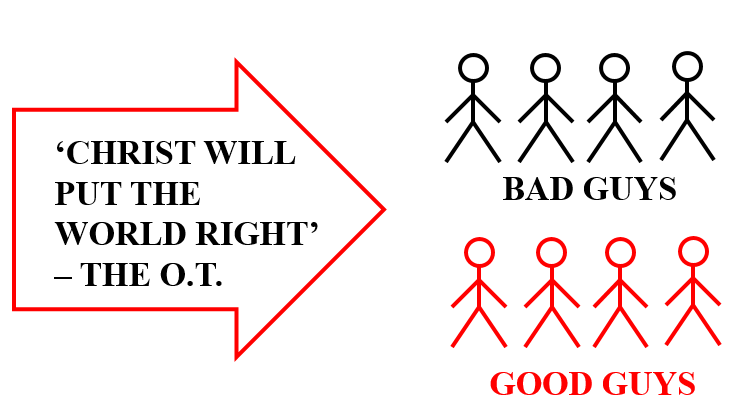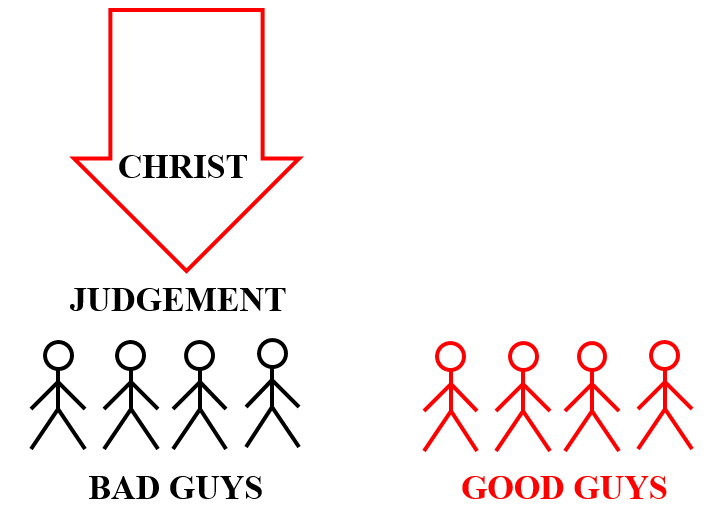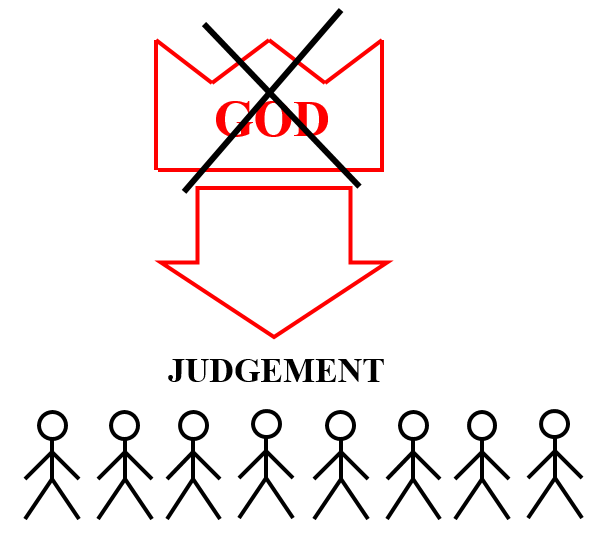Resources
31 March 2024
10:30am
Is Easter believable?
A friend called Paul once looked after the neighbours’ pets while they were away. And the first day he went round, he took his dog, and he’d fed the indoor animals and came out to do the rabbits, only to find his dog with one of them in its mouth - dead. So Paul thought ‘Confess...or cover up?’ And he decided: cover up. Thankfully, the rabbit was all-black (no distinct markings), so he bought a good match in a pet shop, and popped it in the hutch with the others. Well, the day the neighbours got back, they phoned him. And Paul said ‘I hope the animals are OK.’
And the neighbours said ‘They are. We’re just a bit puzzled by the black rabbit. Because we forget to tell you, but the day before we left it died. So we buried it in the garden and we’re just trying to explain to the kids how come Sootie’s alive again’. And you can see their point, can’t you? Because dead rabbits stay dead – although dogs will be dogs and dig them up again.
So Sootie’s ‘resurrection’ didn’t really happen. And many people would say the same about Jesus’ resurrection – maybe you would: ‘It can’t have happened – because dead people also stay dead.’ But the big claim of Easter is that Jesus did rise from the dead. That’s the claim of the account we read earlier. And we’re going to look at it and ask: Is Easter believable? And if it’s true…so what? The words from Luke’s account will come up on the screens, but if you want to follow it in the Bibles, it’s on page 884. And before we go on, I’m going to pray:
Father God,Please lead us into the truth of what happened that first Easter, and help us to go where the truth leads. In Jesus’ name, Amen.
So the first thing Luke says is that:
1. Jesus has risen from the dead
So on the first Good Friday, Jesus was put to death by crucifixion. His body was laid in a tomb cut out of rock, and that was sealed with a large stone. It was also guarded by the authorities who got Jesus crucified, so that none of his followers could move the body and claim he was alive again. So here’s Luke 24.1:
But on the first day of the week [Easter Sunday], at early dawn, they went to the tomb, taking the spices they had prepared.
So they are some of the women who’d followed Jesus. And on Good Friday, they’d seen his body into the tomb. Saturday was the Jewish rest day when they couldn’t do anything. But on the Sunday, as soon as they could, they took more spices back to the tomb to finish off the funeral customs. So they were the original Spice Girls. And they were obviously not expecting a resurrection. They were expecting a dead body. And the eye-witnesses and writers of the Bible are sometimes written off as gullible, unscientific people who’d believe anything. But this shows that isn’t true. And it also shows this isn’t made up because back then the testimony of women was not accepted as real evidence – so if Luke had made this up, there would be no women witnesses. Luke 24.2:
And they found the stone rolled away from the tomb, but when they went in they did not find the body of the Lord Jesus. [And Luke 24.4]…they were perplexed about this.
So they didn’t leap to resurrection conclusions – ‘Hey, the body’s gone, he must have risen’. They puzzled over what could explain its absence because the authorites guarding the tomb were the only people who could have moved the body, and yet they never would have. Because the whole point of guarding it was to stop anything happening that might lead to stories of Jesus being alive again. So…who did move the stone and the body? Luke 24.4:
While they were perplexed about this, behold, two men stood by them in dazzling apparel.
Later, Luke says they’re angels – supernatural messengers from God. And if you’re thinking ‘I can’t swallow that,’ I’d say: just stick to deciding whether or not Jesus rose from the dead. Because if he did, then there is a God and a life beyond this one – and angels stepping in from it to explain what we wouldn’t otherwise understand becomes quite believable. Luke 24.5-12:
And as [the women] were frightened and bowed their faces to the ground, the men said to them, “Why do you seek the living among the dead? He is not here, but has risen. Remember how he told you, while he was still in Galilee, that the Son of Man [which was a name Jesus used for himself] must be delivered into the hands of sinful men and be crucified and on the third day rise.” And they remembered his words, and returning from the tomb they told all these things to the eleven [that’s the apostles – the eyewitnesses Jesus chose to be closest to him] and to all the rest. Now it was Mary Magdalene and Joanna and Mary the mother of James and the other women with them who told these things to the apostles, but these words seemed to them an idle tale, and they did not believe them. But Peter rose and ran to the tomb; stooping and looking in, he saw the linen cloths by themselves; and he went home marvelling at what had happened.
So it gets more strange: there’s no body, just the cloths it was wrapped in. But it’s unthinkable that anyone moving the body would have stripped it. Now if our only evidence was Exhibit A – the empty tomb, all we could say is that Jesus’ body had gone. It wouldn’t mean he’d risen from the dead. But that’s not our only evidence. Because Luke then gives us Exhibit B – the eye-witnesses’ claim that they saw Jesus alive again. Luke 24.13-15:
That very day two of them were going to a village named Emmaus, about seven miles from Jerusalem, and they were talking with each other about all these things that had happened. While they were talking and discussing together, Jesus himself drew near and went with them.
And at first they didn’t recognise him – but when they did, skipping to Luke 24.33-35:
…they rose that same hour and returned to Jerusalem. And they found the eleven and those who were with them gathered together, saying, “The Lord has risen indeed, and has appeared to Simon!” Then they told what had happened on the road, and how [Jesus] was known to them in the breaking of the bread.
And, again, if our only evidence was Exhibit B (the claim that they saw Jesus alive again) there could various explanations for that – from wishful thinking to making it up. But Exhibit A (the empty tomb) plus Exhibit B (Jesus seen alive again) powerfully supports the claim that Jesus has risen bodily from the dead. And if you’re just giving this a first or another look, that’s the big claim which needs looking into. And if you’re up for a bit of reading, you could take away a free copy of one of the Gospel accounts of Jesus. And there’s also a free copy of this booklet called Is Easter Unbelievable? – which includes chapters on ‘Is Jesus life historical?’ and ‘Is Jesus’ resurrection credible?’ Well, back to Luke. He says: Jesus has risen from the dead. And as a result of that, he says:
2. Jesus is putting the world right in his way
So, on that first Easter Sunday, at maybe exactly this time of day, the risen Jesus appeared to these two on the Emmaus road. And he said, ‘What are you talking about? And they said ‘The things that have just happened in Jerusalem.’ Luke 24.19-21:
And he said to them, “What things?” And they said to him, “Concerning Jesus of Nazareth, a man who was a prophet mighty in deed and word before God and all the people, and how our chief priests and rulers delivered him up to be condemned to death, and crucified him. But we had hoped that he was the one to redeem Israel.
So to redeem means to rescue the situation, to put things right. As in, ‘I’ve burnt the dinner – but I think I can redeem it.’ And these two had hoped that Jesus was going to put the world right – but in their way, the way they wanted. So here’s how they pictured the world:

They (Israel) were the good guys, but had to share the place with lots of bad guys.

But they knew that the Old Testament (the Bible before Jesus) said that God would one day send his Christ, his Rescuer-King, to put the world right. And here’s how they thought he should do it:

They thought he should bring judgement on the bad guys. Which would leave them, the good guys, to enjoy a better world. But as far as they could see, the bad guys had just got rid of Jesus, just had him crucified, so all they could say was ‘We had hoped that he was the one to redeem Israel’. So what’s wrong with their picture? Maybe you’d say nothing’s wrong with it. Maybe that’s how you picture the world – with good guys and girls like you, and bad guys and girls like…whatever your list would be. But Jesus would say: what’s wrong with it is that none of us is good. He’d say we do do good – but we also do a lot of bad: to ourselves and to others and to God’s world. And he’d say that’s because consciously or subconsciously we’ve said to God ‘I don’t want you being King in my life – I want to rule it myself.’ So here’s the real picture:

It’s that all of us, by nature, cross God out of our thinking and live as if he wasn’t there. And unsurprisingly, he’s offended and it brings us under his judgement. And that’s the picture Jesus came to put right. And he could have simply put it right by coming in judgement. In which case, where would you and I be?

But that wasn’t his way of putting it right. His way, out of love for us, was to come and take our judgement on himself on the cross, so we could be forgiven back into relationship with him. And these two on the Emmaus road hadn’t realised that’s what God’s Christ, his Rescuer-King, had to do for us. Which is why Jesus explains it in Luke 24.26. He says:
Was it not necessary that the Christ should suffer these things and enter into his glory?
‘Didn’t I have to die for you – and then rise again and return to heaven? Because otherwise you couldn’t be forgiven, and put right with me, and finally join me in heaven when you die. But now you can.’
I guess some of you here are needle workers – from cross-stitchers and dress-makers, to amateur darners like me. And the thing is: once you’ve threaded a needle, whatever the needle goes through, it pulls the thread through after it. And that’s not a bad picture of trusting in Jesus. Because if Jesus is the needle, he’s gone through death for us, removing its judgement as he went, and come out the other side. And if we’re trusting in Jesus, then we’re like the thread – still this side of death, but so connected with Jesus that he’ll pull us through death after him, forgiven and welcome, so that death need hold no fear for us. And that’s why a Christian friend facing terminal cancer said to me just the other day:
‘I don’t like the thought of the ride, but I have no worries about the destination.’ So Luke says: Jesus has risen from the dead, Jesus is putting the world right in his way, and lastly:
3. Jesus wants you to be put right with him
There’s one last bit of Luke’s account that we didn’t read earlier, where the risen Jesus appeared again to his followers, that first Easter Sunday. And once more, he took them back to the Old Testament to explain that his death and resurrection had been God his Father’s plan all along. So Luke 24.45-47:
Then [Jesus] opened their minds to understand the Scriptures, and said to them, “Thus it is written, that the Christ should suffer and on the third day rise from the dead, and that repentance and forgiveness of sins should be proclaimed in his name to all nations, beginning from Jerusalem.
So there are two things that the risen Jesus wants for everyone here – whoever you are, whatever you’ve done, however long you’ve crossed him out of your thinking. And they are: repentance and forgiveness of sins. So repentance just means – turning: turning away from saying, ‘I want to rule my own life’, and turning back to having Jesus as my rightful King. And then forgiveness of sins is what Jesus will meet us with if we do that. Forgiveness for everything in the past, and forgiveness for every way we fail him in the future. Because he paid for all that on the cross. So let me end like this:
Imagine I drew a line of where everyone here stands with Jesus. At one end, there would be those of us who’d say ‘I’m definitely not a Christian. And maybe I’m willing to give this a first or another look. Or maybe I’m just here out of Easter family loyalty’. And if that’s you, thanks for being here. You’re always welcome. And if you’d like to, please take a copy of a Gospel or that booklet Is Easter Unbelievable, or both. Then at the other end of my line would be those of us who’d say ‘I am a Christian. I would say Jesus is my King –though I live for him so imperfectly. But I also know I’m forgiven’. And that’s a great place to be. But you might be somewhere in the middle of my line, and saying ‘I know this is true. And I need to turn to Jesus’. Well I’m going to end with a prayer that would be a way for you to do that. So let me just read it to you first so you can think whether it would be appropriate for you. I’ll pray:
Risen Jesus,I come to you as my rightful King and God. Thank you for dying for me. Please forgive me that I’ve not been living for you. And please take over the ruling of my life from now on.
Now you may be miles further back, and nowhere near ready to pray that. Or you may already have turned to Jesus, and don’t need to begin all over again. But if that prayer would be appropriate for you, you could turn to Jesus now,
by echoing it in your mind as I lead us in prayer. So let’s pray:
Risen Jesus,I come to you as my rightful King and God. Thank you for dying for me. Please forgive me that I’ve not been living for you. And please take over the ruling of my life from now on.
Well if you’ve just prayed that prayer and meant it, you can trust that he has heard and answered it. And if that’s you, can I encourage you to do three things? Number one is to tell another Christian you know that you’ve just taken that step Because that’ll help you underline what you’ve just done, and they can make some suggestions about how to go on from here. Number two is to take away a copy of this booklet Why Jesus? – which is all about starting to follow him. And number three is simply to keep coming Sunday by Sunday to get the encouragement you need to keep following him week by week. We’re going to end with two great Easter songs. And both remind us that if Jesus is like the needle and we are like the thread, he will pull us through death to eternity after him.
Let’s stand.
